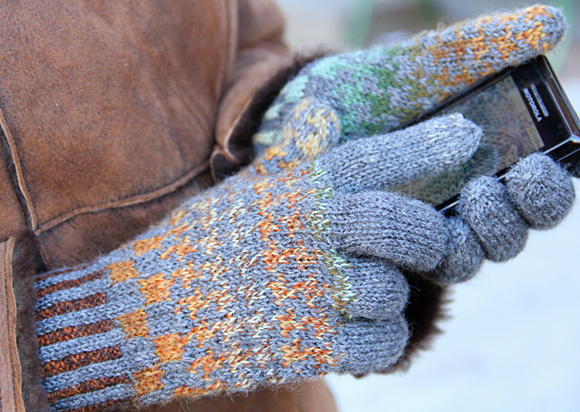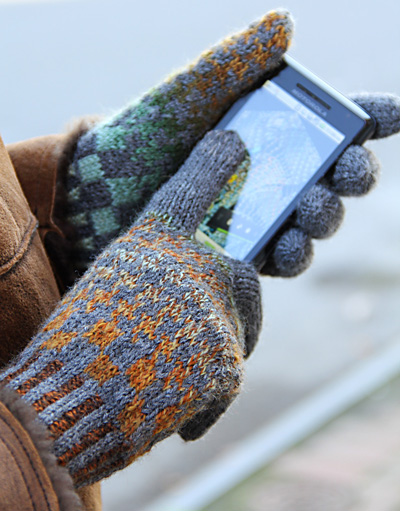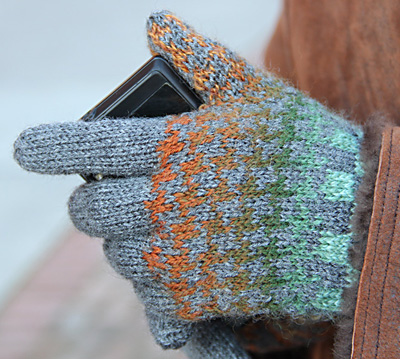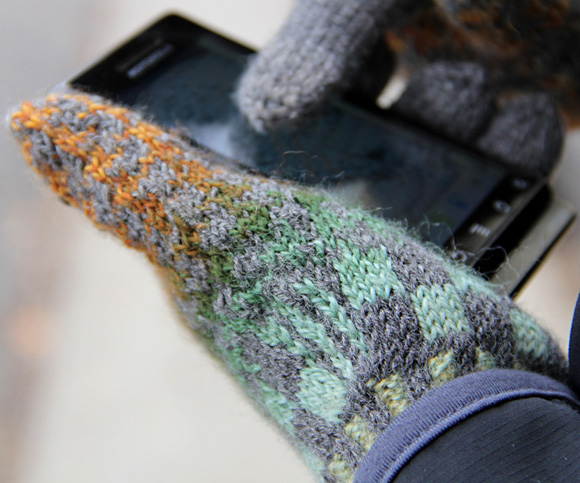

|
|
|

Do you HATE taking off your gloves to answer your phone when
it is freezing out? I do! |
||
|
|

|
Tweet
|
|
SIZE |
|
|
FINISHED MEASUREMENTS |
|
MATERIALS Notions |
|
GAUGE |
34 sts/ 38 rounds= 4 inches in colorwork pattern, in the round, after blocking. |
|
PATTERN NOTES |
|
What is Conductive Thread and WHY use it? Cast-on Notes: Provisional Cast-on M1L: Insert left needle, from front to back, under strand of yarn which runs between last stitch on left needle and first stitch on right needle; knit this stitch through back loop. 1 stitch increased. M1R: Insert left needle, from back to front, under strand of yarn which runs between last stitch on left needle and first stitch on right needle; knit this stitch through front loop. 1 stitch increased. Working Thumb: If your color work gauge becomes tighter on the thumb you can help this by turning your work inside out and working the thumb chart backwards OR using needles one size larger. |
The charts for this pattern are very large and fit on a letter-sized page. Click here and print the resulting page. |
|
DIRECTIONS 
On larger needles and with scrap yarn, provisionally cast on 32 sts. Join CC and knit 1 row, purl 1 row. Join MC, knit 1 row, purl 1 row. Carefully undo provisional cast on and slip resulting 32 sts to a spare needle. Fold in half so that spare ndl is to back of work. Ribbing setup row: Using MC, k2 from front ndl, with CC p2 from spare ndl, rep across until all sts have been worked. 64 sts. Change to smaller needles, distributing stitches as you prefer,
and join for working in the round. Place marker if required
for start of round. Shaping the Thumb Gusset Next round: Work Hand Chart as set to marker, slip 20 sts to scrap yarn or holder, work Hand Chart again to end of round. 64 sts. Continue to work chart through row 30 of chart. Work should measure approx. 3.5 inches from end of rib section. Yarn will be placed to begin pinky finger.  Change to smaller needles. Setup: With MC k8, slip next 50 sts to scrap yarn or holder, CO 2 sts using backward loop over gap, work rem sts. 16 sts. Distribute sts as you prefer and join for working in the round. Knit even until work measures 2 inches from base of finger or until desired length. Decrease round: K2tog around. 8 sts. Work Decrease round once more. 4 sts. Break yarn, leaving a 4-inch tail, thread tail through rem sts, and pull tight. SET UP FOR REMAINING FINGERS Next round: Return 50 held sts to larger needles. Using MC, and leaving a long tail pick up and k4 sts along CO edge of pinky finger, work around to picked up sts as per Upper Hand chart, k2tog twice in pattern. 52 sts. Work 2 rounds even in Upper Hand chart. RING FINGER  Continue with smaller needles. Setup: Using MC, and leaving a long tail pick up and k2 sts along CO edge of ring finger, k8 from holder, leave next 17 sts on holder, CO 1 st over gap, k last 10 sts from holder, join for working in the round, k2tog. 20 sts. Distribute sts as you prefer. Knit even until work measures 2.75 inches from base of finger or until desired length. Decrease round: K2tog around. 8 sts. Work Decrease round once more. 4 sts. Break yarn, leaving a 4 inch tail, thread tail through rem sts, and pull tight. INDEX FINGER 
Return the 20 held thumb gusset sts to larger needles. Using MC and leaving a long tail, pick up and k1 along gap between thumb and hand, work Round 1 of Thumb Chart. (K2tog at end of chart is worked over last of gusset sts and the picked up st.) 20 sts. Distribute sts as you prefer. Work Thumb Chart until round 8 is complete. OPTIONAL CONDUCTIVE ELEMENT: On round 9 of chart begin to knit rest of sts with conductive thread. (See Notes.) Complete all rounds of thumb chart adding on a few rounds of MC at the top if necessary until work reaches top of thumb. Cut other strands when chart is complete. Thumb is completed in MC only. Decrease round: K2tog around. 8 sts. Work Decrease round once more. 4 sts. Break yarn, leaving a 4-inch tail, thread tail through rem sts, and pull tight. |
|
FINISHING |
| ABOUT THE DESIGNER |
|
When Laura is not designing or knitting, she is whipping up yummy feasts with her family, riding her bike, skiing, and taking time to play! You can follow Laura (and her design exploits) on her blog, twitter, facebook, and in her Ravelry group. |
|
Pattern & images © 2011 Laura Nelkin. Contact Laura |